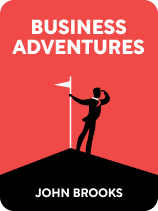

This article is an excerpt from the Shortform book guide to "Business Adventures" by John Brooks. Shortform has the world's best summaries and analyses of books you should be reading.
Like this article? Sign up for a free trial here .
What can you learn from Business Adventures by John Brooks? Is the book still relevant, after all these years?
Business Adventures is a collection of essays about the unpredictability of corporations and Wall Street—and the people behind them. Through 12 in-depth essays, longtime New Yorker contributor John Brooks examines how businesses and economies can rise and fall based on people’s behavior, which is often driven by emotions, habits of thinking, and human tendencies.
Read more for an overview of this business classic.
Business Adventures by John Brooks
Some might say that the book, published in 1969, is outdated, but Microsoft’s Bill Gates believes otherwise. Calling Business Adventures by John Brooks the “best business book ever,” Gates says that despite the many changes in the business landscape since the book came out, the fundamentals of business remain the same. Thus, Brooks’s insights about human nature and the inner workings of Wall Street remain relevant.
In our guide, we explore how human nature led to corporate scandals, stock market setbacks, and major events that shaped the financial world as we know it. We’ve grouped Brooks’s subjects according to theme (which we’ve called “truths”), included commentary about their immediate and lasting effects, and compared them to more recent events. Here’s a synopsis of the six truths.
Truth No. 1
People can be irrational, leading to disastrous decisions. Brooks provides a couple of scenarios that show how letting gut reactions override logical thinking can lead to dire results:
- Collective panic can rock the stock market. Brooks’s first essay illustrates how emotions can drive market behavior, making the stock market inherently unpredictable. As an example, he cites May 28, 1962, when the stock market saw a sharp drop reminiscent of the crash of 1929, leading to widespread panic.
- Even individuals can greatly affect the market. Offering further proof that people are the stock market’s most volatile component, Brooks recaps how a man from Memphis named Clarence Saunders “cornered” his own company’s stock, meaning he obtained enough shares to give him the power to manipulate its price. It wasn’t a calculated move on his part; it was a reaction to Wall Street speculators who had planned an attack on his company, a chain of supermarkets called Piggly Wiggly.
Truth No. 2
Success can make people complacent. People can spend years working hard to achieve success, then relax once they get there. Brooks describes how this complacency can make you blind to threats and weaknesses:
- Some companies stop innovating once they’ve achieved success. Brooks writes about how Xerox’s commitment to innovation led to its success and how its subsequent neglect of innovation led to its decline.
- Big egos can make people feel invincible. Ford Motor Company wasted millions of dollars on the Edsel, a car that is considered one of the biggest product launch failures of all time. Brooks posits that there were a number of factors behind the Edsel’s failure. First, the timing was bad. The Edsel might have been what consumers were looking for in 1955, but the market had changed by the time it was released in 1957. Second, the car itself was mediocre. Third—and perhaps the most damning—the egos of Ford’s executives, designers, and marketers blinded them to the actual demands of the market. Even though the company conducted extensive market research to determine what kind of car consumers were looking for, designers went ahead and created a car based on what they thought consumers would like.
- Stockholders remain indifferent as long as they’re making money. Brooks reflects on how stockholders theoretically hold the power in corporations since they can vote for the board of directors and hold them accountable. However, he notes that most stockholders have no interest in exercising this power—they’re largely docile as long as they receive their dividends.
Truth No. 3
People will take advantage of a complex system to get ahead. Laws and regulations are meant to protect citizens and create an egalitarian society, but they’re often so complicated that people are able to circumvent them on technicalities. In the following essays, Brooks writes about the ways people have exploited loopholes for their personal gain:
- Rich people find creative ways to minimize their income tax. Brooks traces the roots of the federal income tax and discusses how the wealthiest people can get away with paying hardly anything at all.
- People use unclear regulations to their advantage. In addition to exploiting income tax loopholes, people also generously misinterpret ambiguous laws for their personal gain. To illustrate this, Brooks writes about a landmark insider trading case against Texas Gulf Sulphur Company, in which the law’s definitions of “material evidence” and “a reasonable amount of time” were put to the test.
Truth No. 4
People tend to copy what others are doing—even when it’s illegal. While laws and regulations on taxation and insider trading can be somewhat open to interpretation, antitrust laws are more unambiguous: Section 1 of the Sherman Act of 1890 explicitly states that any act restraining trade is considered illegal. One such act is price-fixing, which happens when companies collude to increase their profits by agreeing on a price instead of competing for contracts.
Truth No. 5
One person’s battle can set a precedent. Though laws and regulations can shift based on the whims and follies of Wall Street’s big players, Brooks writes that even one individual can change the legal landscape. In this essay, he discusses a landmark case involving a man named Donald W. Wohlgemuth, whose employer tried to prevent him from accepting another job offer because he had knowledge of trade secrets. The case generated a lot of interest as its outcome would influence other people’s employment terms—if they knew trade secrets, did that mean that they were tied to their employer for life?
Truth No. 6
People can be good, too. Brooks also writes about a few cases when institutions and individuals acted for good.
- Financial institutions are willing to absorb a loss for the sake of the greater good. Brooks writes about two instances when institutions came together and funded what amounted to bailouts to prevent financial crises. The first case was when the NYSE rescued one of its member firms from the brink of insolvency; the second case was when some of the world’s biggest central banks tried to save the pound sterling from devaluation.
- Some people on Wall Street aren’t purely profit-driven. The people of Wall Street may have a reputation for pursuing profits at all costs, but Brooks says that there are those who’ve managed to balance this pursuit with a sense of purpose. In this essay, he profiles David E. Lilienthal, former chairman of the Tennessee Valley Authority (TVA) and, later, chairman and CEO of the Development & Resources Corporation (D & R).

———End of Preview———
Like what you just read? Read the rest of the world's best book summary and analysis of John Brooks's "Business Adventures" at Shortform .
Here's what you'll find in our full Business Adventures summary :
- A collection of essays about the unpredictability of corporations and Wall Street
- How businesses and economies can rise and fall based on people’s behavior
- A look at the major events that shaped the financial world as we know it






